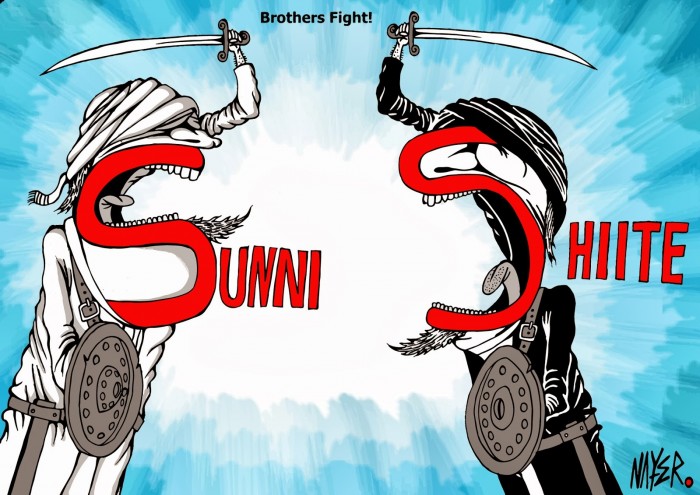Introduction
The socio historical, cultural and political history of Islam is diverse, multi-faceted, which academics thinkers and philosophers has pondered on for centuries., the area under consideration in this research spans the entire history of Islam, but with a specific focus on the flash points and patterns found relating to sectarian relations between different Muslim groups. In This section however, I will gives a brief introduction to the main historical narrative surrounding the divergence of Islam into several different Muslim groups as obtainable today The research will then highlights some of the commonly identified ‘flash points’ in the history of Muslim sectarianism across the globe, with the aim of giving a general overview of how sectarian hostility has been characterised in the past and how it continues today.
Origin of Sectarianism in Islam
Sectarianism emerged in Islam along the Sunni-Shi’a lines. The differences between the Sunni and Shiite Islamic sects are rooted in disagreements over the succession to the Prophet Muhammad, who died in 632 AD, and over the nature of leadership in the Muslim community. The historic debate centered on whether to award leadership to a qualified, pious individual who would follow the customs of the Prophet or to transmit leadership exclusively through the Prophet’s bloodline. The question was settled initially when community leaders elected a companion of the Prophet’s named Abu Bakr to become the first Caliph (Arabic for “successor”). Although most Muslims accepted this decision, some supported the candidacy of Ali ibn Abi Talib, the Prophet’s cousin and son-in-law, husband of the Prophet’s daughter Fatima. Ali had played a prominent role during the Prophet’s lifetime, but he lacked seniority within the Arabian tribal system and was bypassed. This situation was unacceptable to some of Ali’s followers, who considered Abu Bakr and the two succeeding caliphs (Umar and Uthman) to be illegitimate. Ali’s followers believed that the Prophet Muhammad himself had named Ali as successor and that the status quo was a violation of divine order. A few of Ali’s partisans orchestrated the murder of the third Caliph Uthman in 656 AD, and Ali was named Caliph. Ali, in turn, was assassinated in 661 AD, and his son Hussein
(680 AD) died in battle against forces of the Sunni caliph. Ali’s eldest son Hassan (d. 670 AD) is also revered by Shiite Muslims, some of who claim he was poisoned by the Sunni caliph Muawiyah.
Those who supported Ali’s ascendancy became later known as “Shi’a,” a word stemming from the term “shi’at Ali,” meaning “supporters” or “helpers of Ali.” Others respected and accepted the legitimacy of his caliphate but opposed political succession based on bloodline to the Prophet. This group, who constituted the majority of Muslims, came to be known in time as “Sunni,” meaning “followers of [the Prophet’s] customs [sunna].”
The caliphate declined as a religious and political institution after the thirteenth century, although the term “caliph” continued to be used by some Muslim leaders until it was abolished in 1924 by Turkey’s first President Mustafa Kemal Ataturk. The decline and abolition of the caliphate became a powerful religious and political symbol to some Sunni Islamic activists during the nineteenth and twentieth centuries. These activists argued that leaders in the Islamic world had undermined the caliphate by abandoning the “true path” of Islam. Inspired by these figures, some contemporary Sunni extremists, such as Osama bin Laden and others, advocate the restoration of a new caliphate based on “pure” Islamic principles. The religious, ethnic, linguistic, and socioeconomic
diversity that exists within the global Muslim community present significant challenges to the reemergence of centralized, pan-sectarian, and widely recognized Islamic religious leadership.
Subsequent Sectarian Tensions
Since the initial split, the Shi’a branch of Islam has been characterised by some observers, such as Hamid Dabashi, as one of struggle and protest. First under the Umayyads and then the Abbasids, Shi’a communities in the Middle East in early Islamic history experienced institutionalised persecution. Later, the Ottomans also adopted repressive policies towards the Shi’as, particularly as a response to the rise of the Safavids in Persia, who also persecuted Sunnis under their rule. In the modern era scholars have identified three significant periods of sectarianism: after the Iranian Revolution in 1979, after the 2003 invasion of Iraq and after the Arab Spring that began in 2011, which is still on-going. These periods have been formative in shaping current Sunni-Shi’a relations.
Estimates of what proportion of the world’s Muslim population is Shi’a can range considerably from between approximately 8 and 25 per cent, and such a wide range of data can create obstacles for consistency and accuracy. Because of a lack consensus or consistent data, it is difficult to find a figure to use here. Some argue that Shi’a numbers should be estimated towards the higher end of the scale to avoid Shi’as being marginalised. Others, however, argue that Shi’a numbers should be kept conservative in order not to invoke accusations of unfairly inflating the data. Estimations of Shi’a populations can also vary depending on whether the author is Sunni or Shi’a. There is much debate around what can be considered a ‘credible’ source. The Pew Research Centre, which is one source of estimates of Shi’a population figures, discusses how “almost no censuses and relatively few surveys ask Muslims about their Sunni or Shi’a affiliation, which highlights one of the main reasons why accurate data is so difficult to compile. A Congressional Research Report on Sunnis and Shi’as and the BBC information page on Muslim Sectarianism both estimate the global Shi’a population to be between 10 and 15 per cent. However, the CIA World Factbook estimates the Shi’a population to be 10 to 20 per cent and the Pew Research Centre places estimates between 10 to 13 per cent. These give just an idea of the disparity between many different sources and demonstrates the difficultly of giving a definitive estimation. For the purpose of this report it is pertinent to draw attention to this debate but some sort of indication must be given to allow readers to have a reference point from which to orient themselves. The minority status of Shi’a Muslims can therefore be shown by the fact that the majority of the world’s Shi’a population lives in four countries – Iran, Pakistan, India and Iraq -and in only four countries do Shi’as make up a majority of the total population – Iran, Azerbaijan, Bahrain and Iraq.
The Shi’as’ status as a political and cultural minority group has been reflected in the denial of social and civil rights that Shi’a communities have experienced in some Sunni-led states in contemporary times. In Saudi Arabia, the regime has traditionally been hostile to the Shi’ites, believing their practices to be heretical and polytheistic. In Egypt, since the Arab Spring and in the current political situation, concerns are growing for the safety of Egyptian Shi’as, Coptic Christians and other minorities, as reports of public lynchings and communal violence surface. Pakistan has the second largest Shi’a population after Iran, but the Shi’as are nonetheless still in the minority. Currently Pakistan is witnessing a significant intensification of sectarian attacks against both Shi’as and Sunnis. Furthermore, the civil war in Syria could be considered to be increasingly sectarian. The majority of rebels are Sunnis, joined by groups of foreign Sunnis fighting together against the Alawite government, which claims Alawi’ism to be a branch of Shi’a Islam (although this is disputed by some Shi’as). The Lebanese Shi’a militant group Hezbollah has joined the fight on the side of the Government and foreign Shi’as, mainly from Iraq, have been travelling to Syria to protect the many important Shi’a shrines in the country, most notably the Sayyida Zainab Shrine outside Damascus. There has also been evidence of foreign Shi’a militants fighting alongside Government troops, in places like Aleppo.
Sectarian tensions have also been evident in other Middle Eastern countries, for example Bahrain has recently seen increased street protests from the Shi’a population demanding improved social and civil rights. Under Saddam Hussein, reports indicate Iraqi Shi’as suffered sustained repression, particularly after the 1991 Shi’a uprising which followed Iraq’s defeat in the Gulf War. Since the 2003 invasion, Iraqi Shi’as have gained political power but there is still sectarian violence on the streets, in which both Sunnis and Shi’as are targeted. Much of the Sunni states’ concern about Shi’ism is linked to a perception of Shi’as as conduits for the spread of Iranian power across the Middle East. King Abdullah of Jordan warned in 2004 of a ‘Shi’a Crescent’ stretching across the Middle East, expanding Iranian power over the traditionally Sunni-dominated region. The Egyptian Salafi political party, al-Nour, recently declared that by letting Iranian tourists into Egypt they would be leaving themselves vulnerable to a wave of conversions to Shi’ism and, as a result, increased Iranian influence in the country.
There is, therefore, evidence to support claims that the Shi’as has experienced persecution as a minority. Recently in Nigeria the case of attack on Shi’a group during the annual Arabeen festival by the Nigerian troops killing hundreds including the unlawful arrest and detention of its leader.
However, it would be inaccurate to paint a picture of constant and unbroken antagonism between the Sunnis and Shi’as. There is a long tradition of dialogue between Sunni and Shi’a scholars. While the Ottoman and Safavid Empires certainly entered into periods of conflict, they also had periods of relatively peaceful co-existence. Sunnis and Shi’as in Pakistan, Bahrain, Iraq and other states have lived relatively harmoniously together in domestic situations for hundreds of years.
Abd’ Fattah Tolu Alabi writes from Ibadan, Oyo State Nigeria
[email protected] 08039413529





